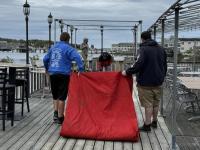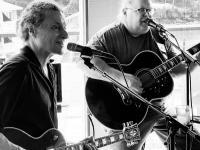Big changes in store for Woolwich dam, fish ladder
Located in the heart of Woolwich, the Nequasset Dam is a place of history as well as transition.
With an increasing number of visitors and volunteer fish counters coming each year to the dam and fish ladder to observe the springtime alewife run, the Bath Water District and the Woolwich Fish Commission have several projects to consider this year that will improve the safety and efficiency of the area when completed.
In addition to there being a lack of safe space for visitors to observe the fish run, an aging valve and underground pipe in the embankment beside the dam needs to be addressed, according to officials.
This time of year, the historic Nequasset Dam is a flurry of activity. Middle May to early June is when the alewives, a small anadromous fish of the herring family, make their way upstream from Nequasset Bay to spawn in the freshwater of Nequasset Lake.
With the fish come crowds of people; scientists to study them, harvesters to catch and smoke them, lobstermen who buy them to use as bait, and members of the local community who are simply excited to witness the remarkable migration of these small fish as they swim and jump against the current and up the old concrete and wood fish ladder.
At the Woolwich Board of Selectmen meeting held on Monday, May 19 at the Woolwich Town Office, representatives from the Woolwich Fish Commission and Kennebec Estuary Land Trust were both present to discuss the construction of a proposed viewing platform at the dam that would open up accessibility of the area to the public. Also discussed was how to best proceed with an inspection of the leaking pipe and aging valve.
The proposed viewing platform discussed at Monday’s meeting is in direct response to the community’s renewed interest in the fish ladder. “People are drawn to the fish ladder,” said Alicia Heyburn, who has been in charge of managing the Nequasset Fish Ladder Reconstruction Project for KELT since it was started in 2010.
The project is an ongoing effort supported in conjunction by the Bath Water District, the town of Woolwich, and the Kennebec Estuary Land Trust to remove and replace the 59-year-old weir fish ladder located at the Nequasset Dam.
With construction of the new ladder not slated to begin until July, discussion regarding the proposed viewing platform is just beginning. Because it is not included in the Reconstruction Project’s scope of work, which has been paid for in large part through grants secured by KELT, there are questions of who will pay for the platform and where it will go.
While the dam and fish ladder are both owned by the Bath Water District, it is part of an easement from the town. Liability issues as well as securing the necessary funds will ultimately determine if and where the platform is built. Heyburn would like to see it paid for by a combination of KELT-sponsored fundraising, state funding and private donations.
Ruth Indrick of KELT is in charge of this year’s fish count. She is thrilled to see such support from the community. “It’s especially amazing to see the kids,” she said. “For those 10 minutes that they’re counting the fish, they’re just so happy to be helping.” But considering the ladder’s close proximity to the dam, it can be a dangerous job.
“We have never had to think about it before, frankly,” said selectman Allison Hepler. “It’s only been fishermen, harvesters, Bath Water District guys, and parents and kids coming down to watch the fish and birdlife that the fish bring.”
Members of the community feel that something has to be done to improve safety at the top of the dam, regardless of whether it’s for the benefit of volunteer fish counters and visitors of the fish ladder or simply for the Bath Water District workers. “It can be a slippery spot,” Heyburn said, “especially after it’s rained.”
Another issue surrounding the dam and fishery is the valve and pipe that supplies fresh water from Nequasset Lake to the fishery harvest area below by cutting through a rock wall embankment beside the dam. The valve tends to stick when opening and closing it; a problem that gets worse every year.
The Woolwich Fish Commission is concerned that failure of the valve could result in losing the ability to open or close it as required. There is also evidence that water is leaking around the pipe and seeping through the stone wall embankment. The leaks occur in the piping when the valve is open. There are concerns that too much leakage could lead to the loosening and failure of the embankment.
At Monday night’s meeting, Bill Potter of the Woolwich Fish Commission proposed to have a closed circuit TV inspection done of the piping and valve to see if the pipe has collapsed and to determine if it is suitable for sleeving.
The inspection would be an alternative to digging up the underground pipe, which could also cause the embankment to fail. The selectmen approved spending up to $5,500 for Atlantic Mechanical, the contractor for the Bath Water District, to inspect the valve and piping.
They plan to subcontract the pipe inspection to a firm that uses closed circuit TV to do this. Potter is hopeful that the pipe and valve can be repaired and salvaged.
The health of alewives
Alewives are an endangered species whose numbers have drastically plummeted in Maine over the past two centuries due in large part to dams, pollution and overfishing. There are 19 alewife runs still open to commercial harvest left in the state of Maine; Nequasset is in the top five.
At the meeting, Bill Potter said that despite a late arrival, the Nequasset alewives seem to be strong this spring. “There’s a ton of fish this year,” Potter said. “The most I’ve ever seen.”
The Nequasset Dam and fish ladder is a place of connection, where many things meet and come together; fresh water and salt water, families and fishermen, history and change. And with exciting new improvements on the horizon this year, it seems that those connections will only become stronger.
The Woolwich board of selectmen meets every other Monday night at the Woolwich town office. Members of the public are invited to attend.
For more information on volunteering for the Nequasset Fish Count, please visit www.kennebecestuary.org.
Event Date
Address
United States

























